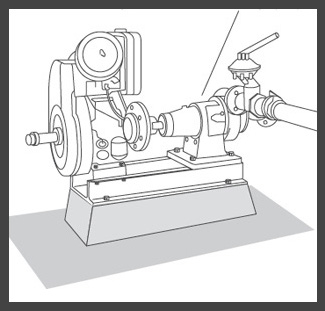Diesel generator pump
| |
|
|
|
|
|
|
|
|
|
Diesel generators are frequently used as a stationary power source. The main parts of the engine are the cylinders, pistons, valves and crankshaft. Air is compressed by a piston inside a cylinder and diesel fuel is injected into it by a high pressure pump, which results in an explosion that moves the piston. In turn, the piston turns a crankshaft, which can be put to use, for example, by driving a pump or electricity generator. Valves in the cylinder regulate the inflow of fuel and air, and the outflow of exhaust gases.
Diesel engines differ from petrol engines in that they do not have spark-plugs to ignite the fuel mixture, and work at much higher pressures. Diesel engines need less maintenance that petrol engines, and they are more efficient. Diesel engines can differ in size (from 1–6 cylinders or more) and speed (revolutions per minute), and by the number of engine cycles (2-stroke, or 4-stroke). In general, low-speed four-stroke engines last longer, and high-speed two-stroke engines produce more power per kg of engine weight. Water-cooled engines generally need less maintenance than air-cooled engines.
- Diesel engines are well-suited for stationary, high-power output;
- with good maintenance they are dependable energy sources;
- it is important to select a brand that has a good reputation, and for which servicing and spare parts are locally available.
Contents
Suitable conditions
Globally used, especially for high-power needs and where no grid electricity is available.
Construction, operations and maintenance
Life cycle: A diesel generator can operate for between 5000–50 000 hours (average 20,000 hours), depending on the quality of the engine, whether it has been installed correctly, and whether O&M has been properly carried out.
Manufacturers: Kubota; Lister-Petter; Lambardini, etc.
A diesel engine must be operated by a trained caretaker, and every engine has its own operating instructions. Before starting the engine, the levels of fuel, oil and cooling water (if not air cooled) should be checked, and topped up if any are low. During operation, the caretaker should check the fuel level and oil pressure, and that the pump and generator are functioning properly. Some moving parts may need to be lubricated manually. The engine speed should also be checked, because if it is too low, the engine will have a low efficiency and carbon rapidly builds up in it. This will increase the frequency with which the engine needs to be serviced. All data on fluid levels and running hours should be recorded in a logbook.
Every day, the outside of the engine must be cleaned and, in dusty conditions, the air filter must be checked and cleaned. In moderately dusty conditions, oil-bath air filters are cleaned once a week, dry-paper air filters a little less frequently. If the engine is connected to a pump or generator with a v-belt, the belt will need to be replaced regularly. Once a year, the engine house must be painted and repaired. The engine is serviced for preventive maintenance according to the number of hours it has run.
Every 50 hours, the clutch (if present) must be greased.
Every 250 hours, the filters must be cleaned or replaced, the oil changed, and the nuts, bolts and exhaust pipe checked.
Every 1500 hours, a major service overhaul will be needed, that includes decarbonising the engine, adjusting the valve clearance, etc. Diesel engines require a lot of simple maintenance and if this is done well, they can have a long service life. Therefore, the training and supervision of the caretaker are important. More complicated maintenance tasks and repairs have to be done by a well-trained mechanic with access to spare parts. The organizing committee must make sure that generator servicing is carried out on schedule, and that they can respond quickly in case the generator breaks down.
Possible problems
— the generator wears excessively, because O&M is poorly carried out, or neglected;
— the engine is run at less than full loading, which leads to rapid carbon build-up and low engine operating efficiency;
— the drive belts break;
— maintenance is required frequently;
— fuel is difficult to get and its cost is high;
— from time to time, a specialist mechanic will be needed to service and repair the generator.
Costs
Initial cost: From US$ 200 per kW for 25 kW engines to US$ 600 per kW for 2 kW engines.
Acknowledgements
- Brikke, François, and Bredero, Maarten. Linking technology choice with operation and maintenance in the context of community water supply and sanitation: A reference document for planners and project staff. World Health Organization and IRC Water and Sanitation Centre. Geneva, Switzerland 2003.

